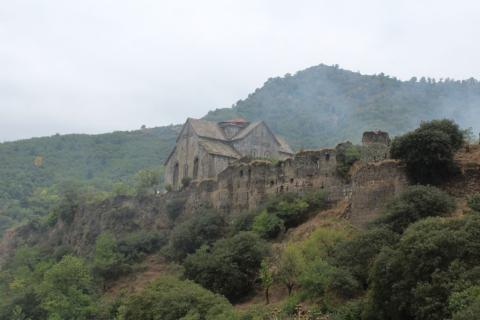Akhtala monastery was our third and last stop during our short one day trip to Armenia, before returning to Tbilisi. Prior to Akhtala monastery we visited Haghpat monastery and Sanahin monastery. The truth is - our trip was made especially to visit Akhtala because of a barbeque festival was held here. I will cover some details (and photos) about that festival in some of the next blog posts, but today I decided to share some photography I captured here at Akhtala.
Just like Haghpat and Sanahin monasteries, Akhtala monastery is located in province of Lari in Armenia (close to Georgian border). However, unlike Haghpat and Sanahin which are plain Armenian Apostolic church elements, Akhtala shares some history with Georgian Orthodox church.
Akhtala monastery
As you can see in the above image, monastery (church) is located on top of (inside) the fortress wall, turns out that the fortress played a major role in protecting the north-western regions of Armenia (Gugark) and is among the most well preserved of all in modern Armenia.
Uphill road leading to monastery complex
Since a barbeque festival was held in Akhtala monastery, we had to make some 1km uphill by foot to reach our final destination
Barbecue festival held at Akhtala monastery
The aim of this festival is to show and tell about Armenian traditional cuisine, also contributing to the development of surrounding tourism. The festival is intended to develop regional tourism, and provide local residents with occupation. Read more: ”Barbecue” Festival in Akhtala
For me it looks very interesting why should a barbeque festival should be held at monastery, but hey it's Caucasus, no questions asked. I will wrap up a separate article about this festival in some of the next posts.
Murals of Surb Astvatsatsin
The murals are one of the best representations of Byzantine art outside the traditional borders of Byzantium. The majority of the murals bare scriptures in Greek. The murals were painted under the patronage of atabek Ivane Zakarian between 1205 and 1216. Parallels have been drawn between the murals and the 11th century Armenian miniature paintings of the Mugni Gospels. The coloring of the murals is characteristic of typical Byzantine art while the thematic solutions are more Armenian. New and Old Testaments scenes as well as various saints including Saint Gregory the Illuminator are depicted on the murals. A large image of the Holy Virgin is depicted in the dome holding Jesus. The mural has been badly damaged and only parts of it survived. Below the Holy Virgin, the Communion is shown where Jesus is depicted twice, turning on the right and left sharing bread with the Apostles. The images of the Apostles Peter, John the Evangelist, Paul and Matthew have survived. The common Christians saints are depicted below the Communion scene, including Pope Sylvester, Saint James the son of Alpheus, Saint John Chrysostom, Basil the Great, Gregory the Illuminator, Jacob of Mtsbin, Clement of Rome, Gregory the Thaumaturgist, Cyril of Alexandria and Eusebius of Caesarea. The murals on the western wall depict the Kingdom of Heaven. The northern wall depicts the trial of Jesus by the high priest of Caiaphas and by the Roman Procurator Pontius Pilate. Some of the murals were renovated in 1979. The arches, niches and columns are also covered by murals.
Dome inside Akhtala church
Altar at Akhtala monastery
Tomb of Prince Ivan Aleksandrovich Melikov
About Akhtala Monastery
Akhtala also known as Pghindzavank ( meaning Coppermine Monastery) is a 10th-century fortified Armenian Apostolic Church monastery located in the town of Akhtala in the marz of Lori, 185 kilometers (115 mi) north of Yerevan. The monastery is currently inactive. The fortress played a major role in protecting the north-western regions of Armenia (Gugark) and is among the most well preserved of all in modern Armenia. The main church at the compound is famous for its highly artistic frescoes, which cover the inside walls, the partitions, and the bearings of the building. The modern name of Akhtala was first recorded in a royal decree of 1438. The etymology of the name Akhtala is believed to be of Turkic origin, meaning white glade. The original Armenian name of the settlement where the monastery is built is Pghindzahank, which means copper mine.

